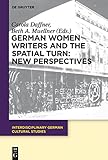German Women Writers and the Spatial Turn: New Perspectives / ed. by Carola Daffner, Beth A. Muellner.
Material type: TextSeries: Interdisciplinary German Cultural Studies ; 17Publisher: Berlin ; Boston : De Gruyter, [2015]Copyright date: ©2015Description: 1 online resource (271 p.)Content type:
TextSeries: Interdisciplinary German Cultural Studies ; 17Publisher: Berlin ; Boston : De Gruyter, [2015]Copyright date: ©2015Description: 1 online resource (271 p.)Content type: - 9783110378207
- 9783110392333
- 9783110378283
- Culture in literature
- German literature -- Women authors -- History and criticism
- German literature -- 20th century -- History and criticism
- Place (Philosophy) in literature
- Space in literature
- Space perception in literature
- LITERARY CRITICISM / European / German
- German Studies
- Spatial turn
- women's writing
- 830.9/9287/09041
- PT148.S718 G48 2015
- PT1334
- online - DeGruyter
- Issued also in print.
| Item type | Current library | Call number | URL | Status | Notes | Barcode | |
|---|---|---|---|---|---|---|---|
 eBook
eBook
|
Biblioteca "Angelicum" Pont. Univ. S.Tommaso d'Aquino Nuvola online | online - DeGruyter (Browse shelf(Opens below)) | Online access | Not for loan (Accesso limitato) | Accesso per gli utenti autorizzati / Access for authorized users | (dgr)9783110378283 |
Frontmatter -- Table of Contents -- Introduction: “Gender, Germanness, and the Spatial Turn” -- I. Transnational Spaces: Mobility and Migration -- Space Across Time and Place -- “Full Steam Ahead!”: Technology, Mobility, and Human Progress in Ottilie Assing’s “Reports from America” -- Dragica Rajcic: War, Space, and No-Place -- Foreign Water: Yoko Tawada’s Poetics of Porosity in “Where Europe Begins” -- Sensing America: Yoko Tawada’s Synesthetic Meditation on Linguistic Spaces in Foreign Tongues -- II. Seeking Space: Gender and Regulation -- Spaces Within -- Repositioning the Exiled Body: Alja Rachmanowa’s Trilogy My Russian Diaries -- The Violated Female Body: Abjection and Spatial Ensnarement in Inka Parei’s The Shadow-Boxing Woman -- Homesick: Longing for Domestic Spaces in the Works of Julia Franck -- Judith Hermann’s “Summerhouse, Later”: Gender Ambiguity and Smooth versus Striated Spaces -- III. Revisited Spaces: Repositionings and Points of Encounter -- Marginalized Spaces, Marginalized Inhabitants -- Elisabeth Langgässer’s Theology of Place: Germany after the Third Reich -- Female Topographies: Depiction and Semanticization of Fictional Space in Monika Maron’s Silent Close No. 6 -- Chance Encounters: The Secrets of Irina Liebmann’s Quiet Center of Berlin (2001) -- The View from the Parking Lot: Political Landscapes and Natural Environments in the Works of Brigitta Kronauer and Jenny Erpenbeck -- Works Cited -- Notes on Contributors -- Index
restricted access online access with authorization star
http://purl.org/coar/access_right/c_16ec
In the last few decades, the phrase “spatial turn” has received increased attention in German Studies, inspired by developments within the discipline of geography. The volume German Women Writers and the Spatial Turn: New Perspectives engages the analytical category of space and the spatial turn in the context of German women’s writing. The collection of essays divides its discussion of spatiality in German literature into sections that reflect privileged sites within the current scholarly debates around space. Essays look to such issues as environmentalism, globalization, migration and immigration, concerns of belonging, points of encounter, spaces and places of (im-)mobility, topographies of departure and arrival, movement, motion, or shifting identities. German Women Writers and the Spatial Turn: New Perspectives continues the challenge to understand the representation of space and place in German language texts by focusing on how spatial theory figures into the realm of feminist thinking and writing.
Issued also in print.
Mode of access: Internet via World Wide Web.
In English.
Description based on online resource; title from PDF title page (publisher's Web site, viewed 25. Jun 2024)


